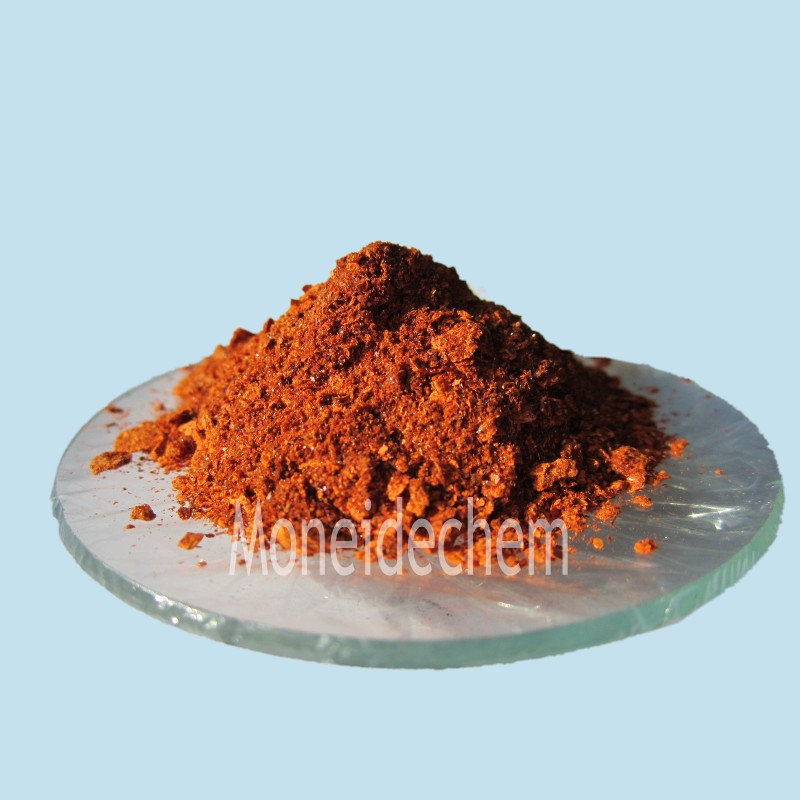Welina mai iā Tangshan Moneide Trading Co., Ltd.
Nā Mea Kimi Moneide
Tel: 86-315-8309571
WhatsApp/WeChat/Mobile: 0086-15633399667
Skype: janet-honest
Leka: sales@moneidechem.com
Wahi: 2-7-523 Jidong Building Materials Tangshan, Hebei 064000 Kina
Alizarin yellow R sodium salt
|
Inoa Kimia |
Alizarin yellow R sodium salt |
|
Another name |
Sodium 5-[(4-nitrophenyl)azo]salicylate; 2-Hydroxy-5-((4-nitrophenyl)azo)benzoic acid monosodium salt; 5-(4-Nitrophenylazo)-salicylic acid sodium salt; Mordant Yellow 3R |
|
CAS No. |
1718-34-9 |
|
ʻAno molekala |
C13H9N3NaO5 |
|
EINECS No. |
217-002-4 |
|
Kaumaha molekula |
309.21 |
|
Hoʻokumu Molecular |
|
|
Nā kikoʻī |
Appearance: yellow powder Assay: 90% min. pH change range: 10.0(yellow)~12.0(red) Water Soluble Test: pass Sulfated ash(as SO4): 20% max. |
|
Noi Nui |
Used as pH indicator. |
What is Alizarin yellow R sodium salt used for?
Alizarin yellow R sodium salt serves as a sensitive pH indicator and metallochromic agent in analytical chemistry. Its primary application is for pH determinations in the moderately alkaline range (pH 10.0-12.0), where it provides clear visual transition points in titration experiments. The compound is particularly valuable in biochemical research for monitoring enzyme activity in alkaline environments. Industrial applications include its use as a colorimetric sensor in water quality testing to detect basic pH shifts. The sodium salt formulation offers enhanced water solubility compared to the free acid form, making it preferable for preparing standardized indicator solutions. Its ability to form complexes with certain metal ions also enables specialized applications in metallurgical analysis and as a staining agent in select histological procedures.
What is the color change of Alizarin yellow R sodium salt?
Alizarin yellow R sodium salt exhibits a distinct color transition from yellow to red-violet across its pH-sensitive range. Below pH 10.0, the solution appears yellow, gradually shifting through orange tones as pH increases. The complete transition to red-violet occurs above pH 12.0, with the most pronounced color change typically observed between pH 10.1 and 12.0. This vivid transformation results from structural changes in the azo-hydrazone tautomeric equilibrium of the dye molecule as it responds to hydroxide ion concentration. The sharpness of this color change makes it particularly useful for visual endpoint determination in alkaline titrations, where many other indicators show less distinct transitions.
What is the Ka value of Alizarin yellow R sodium salt?
Alizarin yellow R sodium salt has an acid dissociation constant (Ka) of approximately 10^-11, corresponding to a pKa value around 11.0. This value indicates the pH at which half of the indicator molecules are in each colored form during transition. The relatively low Ka reflects the compound's weak acid character and explains its sensitivity in the strongly alkaline pH range. The precise pKa can vary slightly depending on ionic strength and temperature conditions, but typically falls between 10.8 and 11.2 under standard analytical conditions. This specific dissociation constant makes it particularly suitable for monitoring pH changes near the critical physiological and chemical threshold where many substances undergo significant reactivity changes.


























